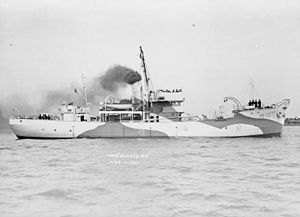Bird-class minesweeper

HMS Blackbird on 11 June 1943
|
|
| Class overview | |
|---|---|
| Name: | Bird class |
| Builders: | Henry Robb Ltd, Leith, Scotland. |
| Succeeded by: | Isles class |
| Completed: | 45 |
| General characteristics | |
| Type: | Minesweeper |
| Displacement: | 607 standard, 923 full load |
| Length: |
|
| Beam: | 30 ft (9.1 m) |
| Draught: | 15.3 ft (4.7 m) |
| Propulsion: | 1,100 ihp (820 kW) oil |
| Speed: | 13 knots (24 km/h) |
| Complement: | 33-35 |
| Sensors and processing systems: |
asdic |
| Armament: |
|
The Bird-class minesweeper was a naval trawler built to Admiralty specifications so it could function as a minesweeper. Forty-five were built. The Royal New Zealand Navy ships were also referred to as corvettes.
The Bird class evolved from the experimental minesweeping trawler HMS Basset, 1935, followed by HMS Mastiff, 1938, both built by Henry Robb Ltd. They were slightly larger and more powerful than these prototypes of what ultimately became the Isles class.
On 29 January 1943, in a classic duel, the Royal New Zealand Navy Kiwi and Moa rammed and wrecked the Japanese submarine I-1. On 19 August 1943 the Royal New Zealand Navy Tui and some United States Kingfisher floatplanes jointly sank the Japanese submarine I-17.
...
Wikipedia
